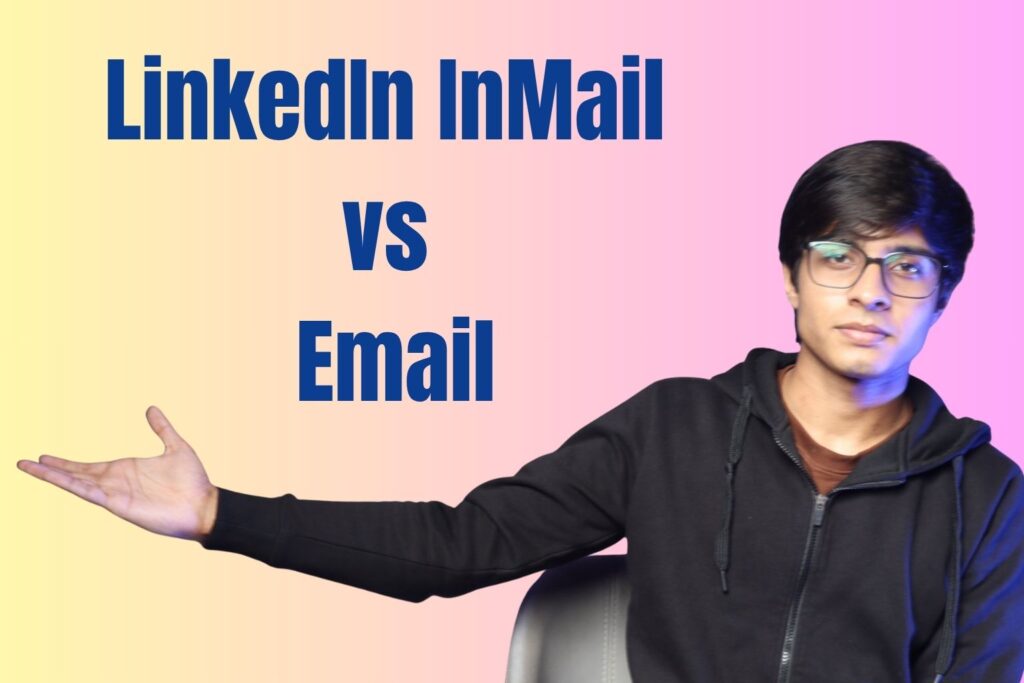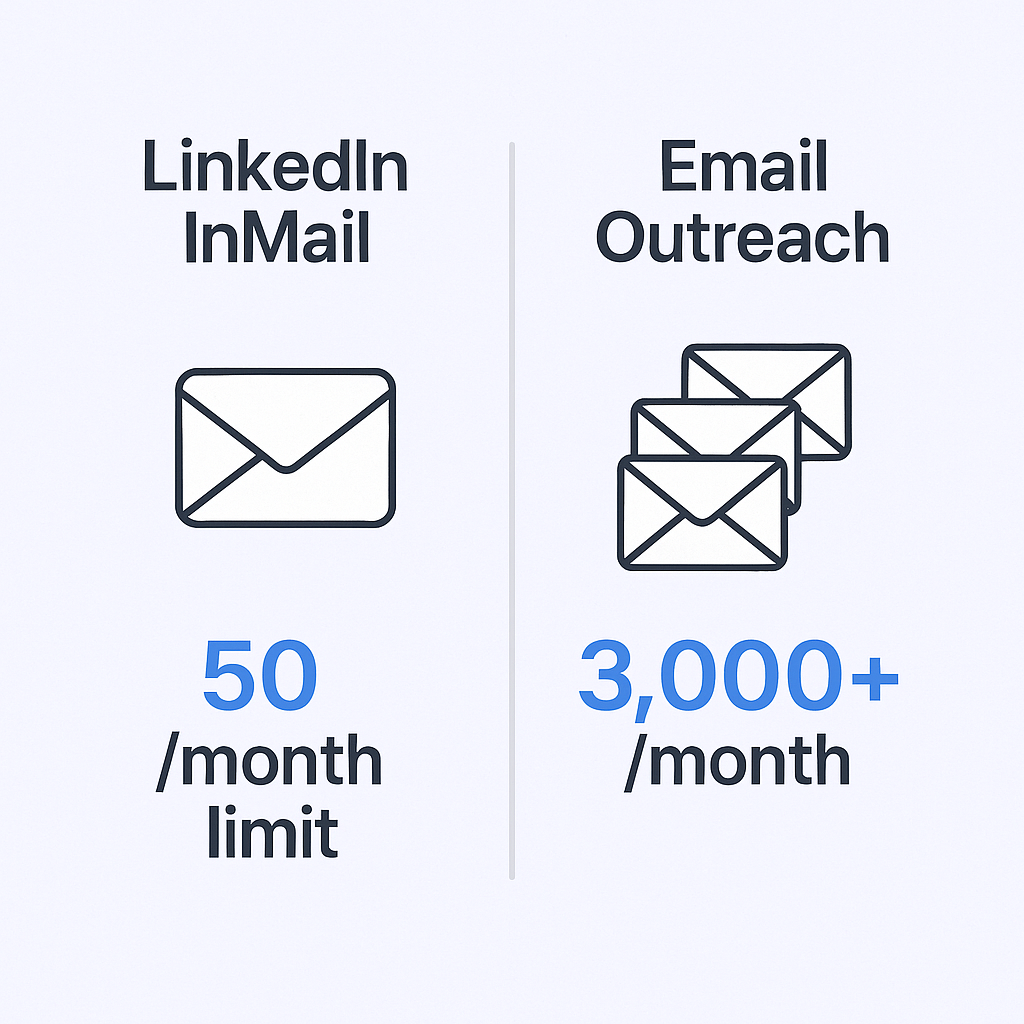- blog
- Cold Emailing
- LinkedIn InMail vs Email: Complete 2025 Comparison Guide

LinkedIn InMail vs Email: Which One Wins for Sales & Marketing in 2025?
Table of Contents
TL;DR: Which One is Better for Sales and Marketing? InMail vs Email
The short answer: both have their place. LinkedIn InMail delivers 10-25% reply rates but limits you to 50 messages monthly. Email gets 1-10% replies but scales to thousands of prospects. Your choice depends on your goals, budget, and target audience.
Quick Decision Framework:
- Choose InMail for: High-value targets, C-level executives, when you can’t find email addresses
- Choose Email for: Volume outreach, automated sequences, cost-effective campaigns
- Combine both for: Maximum impact with strategic multi-channel sequences
What is LinkedIn InMail?
LinkedIn InMail is a premium messaging feature that lets you send direct messages to any LinkedIn member, even if you’re not connected. Unlike regular LinkedIn messages that only work with your 1st-degree connections, InMail breaks through the network barrier.
Key Features:
- Direct access to 2nd and 3rd-degree connections
- Credit-based system – typically 50 credits monthly with Sales Navigator
- Refund policy – get your credit back if they reply within 90 days
- Dual delivery – appears in LinkedIn inbox AND email notifications
InMail operates on scarcity by design. With limited monthly credits, every message must count. This constraint actually drives better results by forcing personalization and strategic targeting.
🎯 Break LinkedIn’s 50-Message Limit
Our outbound engine reaches 3,000+ decision-makers monthly with precision targeting.
What is Email Outreach?
Modern email outreach goes far beyond hitting “send” on a single message. It’s a strategic, multi-touch process designed to start conversations with prospects through personalized, value-driven communication.
Core Components:
- Automated sequences with 5-8 follow-ups over weeks
- Advanced personalization using business intelligence data
- A/B testing for continuous optimization
- Detailed analytics tracking opens, clicks, and replies
Email’s superpower lies in persistence. Research shows 95% of replies come after the seventh follow-up message – a capability that sets email apart from InMail’s one-shot approach.

LinkedIn InMail vs Email: Feature-by-Feature Comparison
Engagement Rates: The First Impression Battle
LinkedIn InMail Performance:
- Open rate: 57.5%
- Reply rate: 10-25%
- Professional context advantage
Email Performance:
- Open rate: 27.7%
- Reply rate: 1-10%
- Inbox competition challenge
Winner: InMail for single-message engagement. LinkedIn’s less cluttered environment and professional context create ideal conditions for higher response rates. When prospects see your InMail, they’re already in a business mindset and can instantly view your professional profile for

Volume and Scalability: The Numbers Game
LinkedIn InMail Limits:
- 50 credits monthly (Sales Navigator Core)
- Additional credits cost up to $10 each
- No follow-up capability without replies
Email Capacity:
- 150-200 emails daily (with proper setup)
- Thousands of prospects monthly
- Unlimited follow-up sequences
Winner: Email dominates here. Small businesses and companies targeting broad markets need volume to fill their pipeline. A single sales professional can reach 3,000+ prospects monthly via email versus InMail’s 50-person limit.
💼 Scale Your LinkedIn Pipeline
Complete campaign design, targeting strategy, and automated sequences that actually convert.
Cost Analysis: ROI Reality Check
LinkedIn InMail Costs:
- $1.60-$2.00 per message (Sales Navigator)
- $10+ for additional credits
- High fixed costs regardless of results
Email Costs:
- Virtually free marginal cost per email
- $36-$42 return for every $1 spent
- Scales efficiently with volume
Winner: Email for cost efficiency. Email marketing consistently ranks among the highest ROI channels in digital marketing. For business owners focused on sustainable growth, email’s cost structure supports scalable operations.
Follow-up Capabilities: Where Persistence Pays
LinkedIn InMail Follow-up:
- Cannot send follow-ups unless prospect replies
- Each additional attempt costs a credit
- Limited nurturing capability
Email Follow-up:
- Automated sequences with 5-8 touchpoints
- Scheduled over days or weeks
- Continuous value delivery
Winner: Email by a wide margin. Professional sales research proves that most conversions happen after multiple touchpoints. Email’s automated sequencing capability allows for systematic relationship building over time.
🚀 Automate Your LinkedIn Outreach
Multi-touch sequences designed for C-level engagement and predictable pipeline growth.
Personalization Power: Quality vs Quantity
LinkedIn InMail Personalization:
- Leverages social context (shared connections, recent posts)
- Profile data readily available
- Professional activity insights
- Limited to platform-specific data
Email Personalization:
- Business intelligence integration
- Technographic data (software usage)
- Company trigger events
- Industry-specific pain points
- Unlimited data source integration
Winner: Draw – Both excel differently. InMail personalizes the human connection, while email personalizes the business problem. Top performers combine both approaches strategically.
Analytics and Optimization: Data-Driven Improvement
LinkedIn InMail Analytics:
- Basic response rates
- Limited engagement metrics
- No A/B testing for individual messages
- Template performance tracking
Email Analytics:
- Open rates, click rates, reply rates
- Sequence performance analysis
- Advanced A/B testing capabilities
- AI-powered sentiment analysis
- Deliverability metrics
Winner: Email for data-driven teams. Email platforms provide granular insights that enable continuous optimization. This analytical depth is crucial for refining messaging and improving results over time.
What’s the Right Channel for You?
Choose LinkedIn InMail When:
High-Value Target Scenarios:
- Pursuing enterprise accounts worth $50K+ annually
- Targeting C-level executives with gatekeepers
- Account-based marketing to Fortune 500 companies
- Unable to locate verified email addresses
LinkedIn-Active Prospects:
- Daily LinkedIn content creators
- Regular platform engagement
- Industry thought leaders
- Professional services executives
Strategic Account Penetration:
- Breaking into dream accounts
- Reaching unresponsive email contacts
- Final outreach attempt to qualified prospects
Choose Email Outreach When:
Volume-Based Sales:
- Reaching hundreds of prospects monthly
- Building predictable pipeline flow
- Velocity sales models with shorter cycles
- Cost-conscious growth strategies
Long-Term Nurturing:
- Complex solutions requiring education
- Extended sales cycles (6+ months)
- Building brand awareness over time
- Providing ongoing value to prospects
Small Business Targeting:
- SMB market penetration
- Local business outreach
- Entrepreneurs and small business owners
- Price-sensitive market segments
The Elite Multi-Channel Strategy
Top performers don’t choose one channel – they orchestrate both. Here’s a proven 10-day sequence that maximizes both platforms:
Day 1: LinkedIn profile view (soft introduction) Day 3: Personalized email #1 with business value Day 5: LinkedIn connection request with context Day 7: Email #2 with relevant case study Day 10: Strategic InMail as “pattern interrupt”
This approach leverages email’s cost-effectiveness for multiple touches while using InMail’s high visibility as the decisive blow. The prospect has seen your name multiple times, making the InMail feel warmer and more familiar.
📈 Get Your Custom Outreach Blueprint
H2: We design LinkedIn campaigns that combine targeting precision with scalable execution.
7-day Free Trial |No Credit Card Needed.
LinkedIn vs Email: FAQs
Does LinkedIn InMail go to email?
What is the difference between InMail and message on LinkedIn?
How many InMails do I get with LinkedIn Premium?
Why do I get emails from LinkedIn?
Which platform has better targeting options?
The Complete Outreach Strategy Framework
Success in modern sales requires understanding that LinkedIn InMail and email serve complementary roles in your outreach ecosystem.
Email as Your Foundation: Build a scalable system that can reach thousands of prospects monthly. This creates consistent pipeline flow and supports your activity-based metrics. Email’s automation capabilities handle the heavy lifting of follow-up sequences while you focus on high-value activities.
InMail as Your Precision Tool: Deploy strategically for breakthrough moments with your most important prospects. When email sequences aren’t generating responses from dream accounts, InMail serves as your “pattern interrupt” – a fresh approach that demands attention.
The Integration Advantage: The most successful outreach professionals use both platforms synergistically. They build awareness and familiarity through email touchpoints, then use InMail’s high visibility to break through when timing is critical.
Platform Selection by Market Segment:
- Enterprise sales: Email foundation + InMail for executives
- SMB targeting: Email-first with occasional InMail for key accounts
- Professional services: Heavy LinkedIn focus with email nurturing
- SaaS/Technology: Multi-channel approach based on buyer personas
- Ecommerce sales: Email-dominant with LinkedIn for B2B partnerships
Budget Allocation Guidelines:
- Startups: 80% email, 20% InMail budget
- Established companies: 60% email, 40% InMail budget
- Enterprise focused: 40% email, 60% InMail budget
The key insight: this isn’t an either/or decision. It’s about building a comprehensive outreach system that leverages each platform’s unique strengths while mitigating their individual limitations.
Your success depends not on choosing the “perfect” platform, but on executing a strategic combination that aligns with your target market, sales cycle, and growth objectives. Start with the platform that matches your immediate needs, master it completely, then layer in the complementary channel for maximum impact.
Remember: in the attention economy, diversification isn’t just smart – it’s survival. The prospects who ignore your emails might engage with your InMails, and vice versa. By mastering both channels, you ensure no opportunity slips through the cracks.

Segmentation That Actually Converts
LinkedIn outbound targets precise demographics with strategic campaign design and scaling methods

